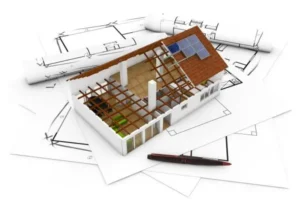How the arquitetura app works to draw houses
How the architecture app for designing houses works
Architecture apps for designing houses function as multifunctional digital tools that allow users to create, visualize and modify construction projects intuitively and efficiently.
These apps are designed to be accessible, offering user-friendly interfaces and a wide range of resources that make the architectural design process simpler and faster.
We will detail how these apps work in different aspects of architectural design.
Creation of 2D drawings
The first step in the design process in an architectural app is the creation of a 2D plan.
This is the skeleton of your project, where you outline the basic structure of the house.
Architectural apps generally offer an intuitive interface where you can draw walls, doors, windows and other structural divisions with ease.
Drawing interfaceMost apps offer a drawing interface that allows you to draw walls and define room divisions. You can adjust the dimensions, define the thickness of the walls and choose materials such as brick, plaster or concrete directly in the 2D interface.
Precision toolsIn addition, these apps are equipped with precise measuring tools that ensure that every line and angle is drawn accurately. You can use rulers, digital compasses and other tools to adjust every detail of your plan.
Once the basic plan is complete, you can add additional elements such as doors, windows and interior partitions.
The app generally offers a library of preconfigured objects, making it easy to insert these elements into your design.

Transformation to 3D modeling
After creating the 2D plan, the app allows you to transform that design into a 3D model.
This functionality is essential to obtain a realistic view of the project and make adjustments before moving on to the construction stages.
Automatic creation of 3D modelsMost architecture apps allow you to instantly convert the 2D floor plan into a 3D model. This model can be explored from different angles, allowing you to see how each room connects to the rest of the house and how the elements line up in the three-dimensional space.
3D navigation tools3D navigation tools allow you to rotate, zoom and move within the model as if you were walking through the house. This provides a clear perspective on the layout of the space, the interaction between the different environments and the overall aesthetics of the project.
3D modeling not only facilitates the visualization of the final project, but also makes it possible to identify and correct errors that may not be evident in the 2D plan.
This reduces the risk of problems during construction, saving time and resources.
Customization of materials and finishes
After creating the 3D model, the next step is to customize the materials and finishes.
Architecture apps offer a wide range of options to customize the interior and exterior look of the house, allowing you to experiment with different combinations until you find the one that best suits your project.
Material selectionYou can apply different materials to walls, floors and ceilings. Options generally include wood, stone, concrete, glass, among others. In addition, you can choose colors and textures, visualizing how each choice impacts the overall design.
Lighting simulationSome apps allow you to simulate lighting, both natural and artificial. This helps to see how light interacts with selected materials and how different lighting configurations can alter the atmosphere of rooms.
Customization of materials and finishes is one of the most creative parts of the design process, allowing you to transform a basic structure into an aesthetically pleasing and functional space.
Architecture app resources
Architecture apps come equipped with a number of resources that make the architectural design process more efficient and accessible.
These resources are designed to support all phases of the project, from initial conception to finalization of details.
Accurate measuring tools
One of the most important features in any architectural app is measurement accuracy.
The integrated measurement tools allow you to calculate distances, areas and volumes with extreme precision, which is crucial to ensure that projects are within the desired specifications.
- Distance measurementYou can measure the distance between different points on the plan or on the 3D model, making sure that everything is proportional and dimensioned correctly.
- Calculation of areas and volumesThe apps also offer automatic calculations of areas and volumes, which helps in cost estimation and in the choice of materials. For example, calculating the total area of a floor or the volume of an internal space is simple and fast, allowing better project management.
These measurement tools are essential not only for design accuracy, but also to ensure that the final project is functional and within budget.
2. 3D object library
Another essential feature of these apps is the 3D object library.
These libraries include a wide range of furniture, appliances and other decorative elements that can be inserted into the model to give a clearer idea of how the space will be used.
- Furniture and decorationLibraries generally include furniture such as sofas, beds, tables and chairs, as well as decorative elements such as plants, pictures and light fixtures. These objects can be resized and repositioned as needed to adjust the layout of the space.
- Architectural componentsIn addition to furniture, libraries also include architectural components, such as staircases, balconies and columns, which can be incorporated into the design to add functionality and aesthetics to the project.
These 3D objects not only help visualize the layout of the space, but also allow for testing different configurations and styles, facilitating the creation of a cohesive and functional design.
3. Real-time rendering
Real-time rendering is an advanced feature that allows you to visualize your project in high quality while you work on it.
This means that you can immediately see how each change affects the design, without having to wait for a long rendering process.
- Instant displayAs you adjust materials, colors and lighting, the 3D model instantly updates to reflect these changes. This makes it easy to make quick and informed decisions during the design process.
- Environment simulationReal-time rendering also allows simulating different environmental conditions, such as daylight at different times or the effect of shadows and reflections, providing a more realistic view of the final project.
This functionality is especially useful for presentations to clients, as it allows to show exactly how the project will look like, with all details visible in real time.
Benefits of the architecture app
Using an architecture app to design houses brings a number of benefits that go beyond the simple convenience of working on a mobile device.
These tools offer significant advantages for design professionals and enthusiasts alike.
Accessibility and mobility
Architecture apps can be used on smartphones and tablets, making home design accessible anywhere and anytime. This is especially useful for professionals who need to work on projects while traveling or visiting clients.
- Remote workWith these apps, you can continue working on your projects even outside the office, ensuring that work is not interrupted. This also allows you to show project progress to clients in external meetings, without the need to carry bulky equipment.
- Real-time collaborationSome apps allow real-time collaboration with other team members, facilitating joint work and the exchange of ideas, regardless of the physical location of each person.
For whom it is useful: Architects, interior designers and freelancers particularly benefit from the mobility offered by these apps, allowing them to work flexibly and efficiently.
Time savings
By automating tasks such as calculations and renderings, architecture apps help save valuable time, allowing you to concentrate on the creative aspects of design.
- Automated processesThe ability to automatically generate 3D models from 2D drawings, calculate areas and volumes, and quickly apply materials significantly speeds up the design process. This reduces the time spent on repetitive tasks and allows the focus to be on more strategic aspects of the project.
- Quick settingsWith the ability to make adjustments and visualize changes instantly, you can experiment with different design solutions quickly and efficiently, without waiting for time-consuming renderings or manual calculations.
For whom it is useful: Designers working under tight deadlines or managing multiple projects at the same time will find great value in the efficiency these apps provide.
Interactivity with the customer
One of the main advantages of architecture apps is the ability to dynamically interact with clients, displaying detailed 3D models and making changes in real time based on their feedback.
- Dynamic presentationsYou can present the project to the client on a mobile device screen, allowing them to view the design from different angles and at various levels of detail. Changes can be made instantly, and the client can see how they affect the overall project.
- Customer participationThis interactivity increases customer involvement, facilitating immediate feedback and ensuring that the project meets expectations from the outset.
For whom it is useful: Professionals who work directly with clients, such as architects and interior designers, will benefit greatly from the ability to make presentations more immersive and interactive.
Cost reduction
By using an architectural app, you can significantly reduce the costs associated with architectural design, eliminating the need for expensive software and specialized hardware.
- Low cost of entryMany apps offer robust functionality at a fraction of the cost of traditional design software. This makes architectural design accessible to a wider audience, including freelancers and small firms that may not have the budget for more expensive tools.
- Operational efficiencyTime reduction and efficiency provided by the app's functionalities also contribute to cost reduction, allowing projects to be completed faster and with fewer resources.
For whom it is useful: Small design studios, freelancers and architecture students can find a cost-effective and efficient solution in architecture apps, without compromising the quality of the projects.
Experimentation and creativity
Architecture apps allow you to experiment freely with different concepts and ideas without the risk of wasting resources, encouraging creativity in design.
- Exploration of ideasYou can create several concepts and iterate on them quickly, trying out different layouts, materials and configurations before committing to a single idea. This allows you to explore a wider range of possibilities and find innovative solutions.
- No physical limitationsBecause the entire process is digital, you are not limited by materials or costs during the experimentation phase, which frees your creativity and allows you to develop bolder and more unique designs.
For whom it is useful: Architecture students, beginning designers and anyone interested in exploring creativity in design will find architecture apps indispensable tools for developing their skills and ideas.
Does the architecture app work?
Yes, architecture apps work effectively to create detailed and accurate design projects.
They are developed with a wide range of tools that facilitate the drawing of plans, 3D modeling and customization of finishes with high precision.
Reliable performance
These apps are designed to run on modern mobile devices, taking full advantage of the available hardware to deliver a smooth and flawless design experience.
Even on devices with more modest specifications, many apps manage to deliver satisfactory performance, thanks to careful optimizations by developers.
Continuous support
Most architecture apps receive regular updates that add new features, fix bugs and improve performance.
This ensures that the application continues to meet user needs as technology evolves.
The application works well for both professionals and amateurs, making it a reliable tool for anyone wishing to create quality architectural projects.
Is the architecture app secure?
Yes, architecture apps are developed with rigorous security protocols to protect user data and information.
Security is a priority, especially when it comes to architectural projects that may involve sensitive information.
Data protection
Many of these apps use end-to-end encryption to protect stored and transferred data.
This means that both the projects and the user's personal information are protected against unauthorized access.
Secure cloud storage
If the app offers integration with cloud storage services, it usually includes additional security measures, such as two-factor authentication and automatic backups, to ensure that your projects are always secure and accessible only to you.
In addition, it is important to always download apps from trusted sources, such as the App Store or Google Play, to ensure that you are using a legitimate and safe version of the application.
How can the architecture app help you?
An architecture app can be a powerful tool to transform your ideas into reality.
Whether you are an experienced architect or a design novice, these apps offer features that facilitate the creation process, from the initial sketch to the detailed 3D model.
- Complete toolsWith a wide range of design tools, from 2D drawing to 3D modeling, you have everything you need to create detailed and accurate projects, without the need for additional software.
- Flexibility and accessibilityThe ability to work on your projects anywhere, anytime offers unparalleled flexibility, allowing you to adjust designs as needed, without being limited to a single workspace.
These apps can help streamline your workflow, improve the quality of your projects and offer a convenient way to present your ideas to clients and colleagues.
Is the architecture app worth downloading?
Yes, it is very much worth downloading an architecture app, especially if you are involved in home design projects or have an interest in learning more about architecture.
These apps provide a practical and accessible way to create detailed and realistic designs, saving time and resources.
Cost-benefitLow cost compared to traditional design software makes these apps an economical choice, without compromising quality or functionality.
Professional resultsDespite being an affordable tool, architecture apps can produce professional results, making them a valuable addition to any designer or architect's arsenal.
If you are looking for a complete and practical solution for architectural design, architectural apps are an excellent choice that offer flexibility, functionality and a high level of accuracy.
Our opinion
Architecture apps are a transformative innovation in the world of design, offering an accessible, efficient and powerful solution for creating high-quality architectural projects.
They combine advanced functionality with a user-friendly interface, making the design process more accessible to all skill levels.
If you haven't experimented with an architectural app yet, now is the perfect time to start.
With a wide range of resources, from drawing plans to 3D modeling and customizing materials, these tools are ideal for anyone interested in designing homes.
In conclusion, architecture apps not only facilitate the design process, but also foster creativity and innovation, allowing you to explore new ideas and transform your projects into reality in an efficient and practical way.





